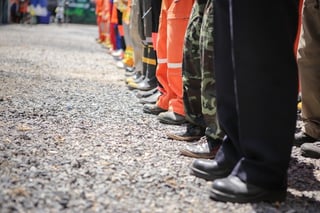 The 2017 National Survey on EMS Disaster and Major Casualty Incident (MCI) Preparedness issued by the National Association of Emergency Medical Technicians (NAEMT) reveals most EMS responders have received training in disaster response and are practiced in incident response protocols.
The 2017 National Survey on EMS Disaster and Major Casualty Incident (MCI) Preparedness issued by the National Association of Emergency Medical Technicians (NAEMT) reveals most EMS responders have received training in disaster response and are practiced in incident response protocols.
The survey, finalized in November 2016, was based on responses received from 1,150 EMTs and paramedics across the U.S. Although respondents expressed a degree of confidence, the survey revealed several deficits in readiness, especially in the fields of education and training, as well as in specifics such as chemical and biological incidents.
Important Findings from the Survey
The report covered all aspects of emergency preparedness. Most notably, it revealed:
- Experience in disaster response: Although 49% of EMS managers have had disaster response experience, only 36% of EMS practitioners have experience with disaster response.
- Personal and family preparedness: Recognizing the risk to their families, 63% of EMS families had household emergency preparedness plans in place, and 75% maintained a minimum 3-day supply of food, water, and medicine.
- Disaster preparation education: Most have received basic training in National Incident Management System (NIMS) disaster response, but less than half have pursued advanced courses, and few attend refresher training.
- Mutual aid agreements: Most units have mutual aid agreements in place with other agencies.
- Terrorism: Despite its high profile, most personnel don't receive briefings, and are unaware of potential terrorist threats.
- Training for Major Casualty Incidents (MCI): Nearly half have never received training in major disaster response while two-thirds have been trained in MCI triage.
Specific Levels of Confidence in Disaster Preparedness
From incidents that affect a few individuals through MCIs that impact entire communities, disasters come in many shapes and sizes. EMS practitioners self-rated their knowledge in response protocols for such incidents as follows:
| Response Protocol | Confidence (%) |
|---|---|
| Major Casualty Incident | 69 |
| Explosive Injuries | 59 |
| Active Shooter Incidents | 58 |
| Natural Disasters | 55 |
| Chemical Incidents | 41 |
| Biological Incidents | 39 |
| Radiological Incidents | 37 |
| Pandemics | 32 |
It's notable that confidence levels and expertise in seldom-occurring but potentially serious incidents are low.
Reasons for Lack of Disaster Preparation
While most understand the need to be prepared for any type of disaster, this is not always practical for several reasons, including:
- Cost: Limited funding is the biggest reason for lack of emergency preparedness (75%).
- Limited resources: Closely linked to funding, the ability to release resources for training is constrained by manning levels and workload.
- Complacency: 68% of respondents reported that lack of overall preparation is linked to a perception that a major disaster is unlikely.
While funding and manning constraints are understandable, major disasters are unpredictable and may strike anywhere.
Suggested Follow-Up
The 2017 survey concluded with a recommendation that levels of preparedness should be increased and complacency dispelled. It also pointed to the need for closer links with federal authorities, especially regarding involvement in national initiatives.
At Graham Medical, we are serious about our commitment to the EMS and paramedic professionals. We support your need for training and preparation and are heavily involved in active shooter training. We are also pleased to be able to provide career extending equipment like the MegaMover® patient transport unit. Contact us here, or call us at (800) 558-6765 for a free sample.

